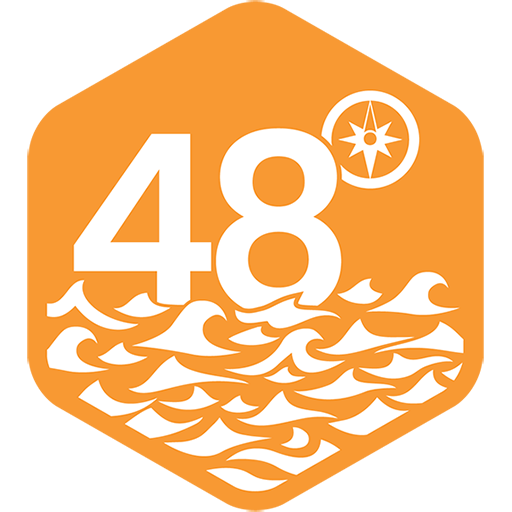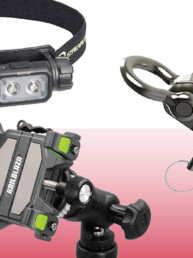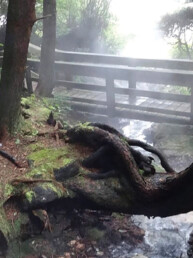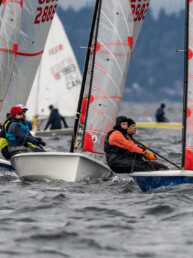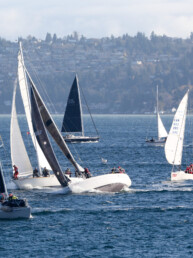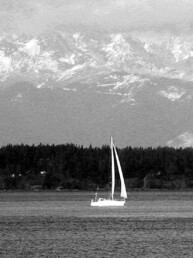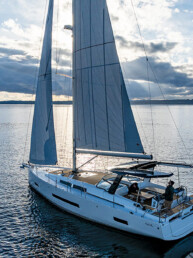Grand Banks Yachts are well known throughout the Pacific Northwest and beyond as sought-after powercruisers that are comfortable and capable, especially when plying the waters of the Inside Passage. Indeed, that was part of the requirement for Ron Moller when he was searching for a boat to live out his dream of cruising in retirement. But it goes a bit deeper than that. Moller has had a long history of boating in Puget Sound, and it was his late father who turned him on to the Grand Banks name. Eventually, this led him to a boat that he has come to cherish—his beloved 1983 Grand Banks 42 Classic, Gravenstein.
Tell us about your boat’s name.
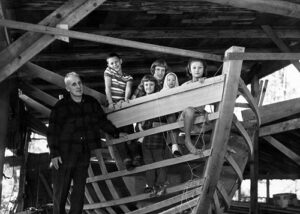
The baby pictured is the author.
My dad built boats, from plywood skiffs to a 34-foot mahogany-planked sailboat, and many between. I grew up on and around the water, third generation at the family homestead on Colvos Pass just north of Gig Harbor. When we’d see a Grand Banks trawler go by, Dad would point it out—he loved the sturdy workboat lines, and apparently that rubbed off on me. Today, the old family farm is Sunrise Beach County Park if you’d like to cruise by for a visit and to see one of the few remaining fruit trees, which are 120-plus years old by now. Like boat designs, my dad’s taste in apples aligned with my own, and our favorite was always Gravenstein. He passed away 30 years ago, but when I was ready to own a cruising boat there was no question what I wanted, and the name is a nod to my father, Rudy Moller.
Have you owned other boats before this one?

Yes. What could be a better idea than two friends home from college buying a leaky $500 wooden 26-foot ChrisCraft Sedan Cruiser that was over 40 years old? It turned out that all of the underwater bronze was so wasted that the rudder simply broke off one day. “Ummm, Paul… the boat won’t steer.” We fixed it by bolting a plywood rudder onto the stub.
Another time, while backing away from our dock, the propeller retaining nut crumbled and the prop went spinning to the bottom of Gig Harbor. “Ummm, Paul… the boat won’t go forward.” He dove down and retrieved it and we bought a new retaining nut. Believe it or not, by the end of summer we ran it all the way to Montague Harbour, British Columbia and back with my future wife and a couple more friends aboard—and only had two minor crises along the way!
After a 25-year gap raising a family and living in the San Francisco Bay Area, next up was a 1978 Tollycraft 30 bought in Tacoma. I was grateful to that boat (we named her Tusen Takk, which is Norwegian for “thousand thanks”) for getting me back on the water and up to the San Juan Islands with family a few times, but she wasn’t a keeper. Three years later we sold the Tolly and purchased Gravenstein.
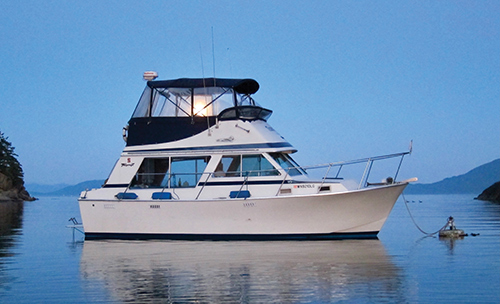
Tell us the story of how you found your boat and what makes it special to you.
A Seattle friend recommended a yacht broker and I told him that Grand Banks was my preferred brand, but best to buy in a couple years when I was closer to retirement. I flew in for a weekend to walk the docks with him and see a few boats… along with the same friend that owned the ChrisCraft with me 30 years earlier. From there, it was a Three Bears story: We went aboard a Grand Banks 36, 42, and 46. As a tall guy, the 36 felt sweet and cozy but too small, the 46 was gorgeous but unnecessarily big, and the 42 fit just right.
With that settled, and some specific preferences outlined with the broker, we went back to life and work, not expecting to hear from him for a year or two. A couple months later, though, he called me at work from the engine room of a Grand Banks 42 and said, “Uhhh Ron, I know it’s early but I’m pretty sure I’m on your boat.”
All these Grand Banks were semi-custom, with many configuration options from the factory. I’d outlined “must haves” and “wants” with the broker and this boat hit them all. It also had the bonus of always being moored on Seattle lakes, including the first 20 years in a boathouse, so there was very little corrosion or weathering. He sent me photos and particulars, and I flew up that weekend for a walk-through. I then put in an offer, which was accepted pending inspection and sea trial. The boat passed with flying colors and, eleven years later, I am still grateful for that phone call.
Gravenstein was built for a Seattle businessman, lightly used for 20 years, then sold to an airline mechanic for the next 10. I can highly recommend buying from an airline mechanic, as they are quite particular about maintenance. With me as her third owner, Gravenstein now floats in the salty stuff all year, and there are no boathouses in Port Townsend—so we’re well underway with “weathering” at this point.
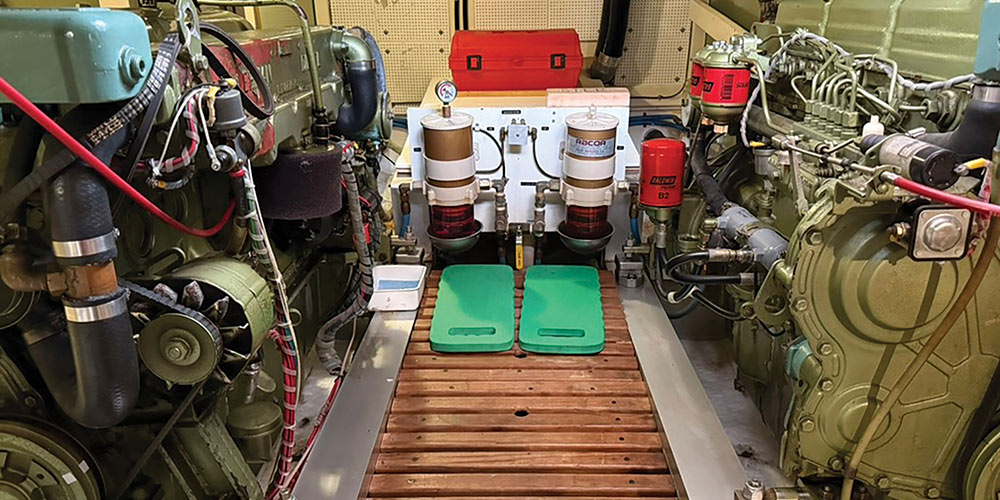
What’s the history of your boat? Tell us its story.

Grand Banks 42s were originally a Ken Smith design, built from 1965 through 2004, initially in Hong Kong, then in Singapore. The hulls were wood, then they switched to fiberglass in 1973. There has been a considerable evolution along the way, but at first glance it’s hard to guess the age.
For my tastes, the 1980s Grand Banks hit the sweet spot. There were a handful of salon and stateroom refinements over the earlier models, but they are still relatively simple boats. Gravenstein has twin 120hp Lehmans, which was the most common choice in that era. From about 1990 onward, the market demanded more power and more luxury features. They were still lovely yachts, of course, but they became more expensive to buy and maintain.
Gravenstein cruises at 7.2 knots at 1500 RPM and burns 2.6 GPH. The fuel tanks hold 560 gallons, so we could run from Port Townsend to Ketchikan and back without refueling. We haven’t done that yet, but it means that even with multiple trips in Washington and British Columbia waters every season, we refuel just once a year.
What do you like best about your boat?
I’m fond of its high level of quality in design, construction, materials, and equipment from Grand Banks, along with what is for me the ideal size and layout for a Pacific Northwest cruising boat. There are private cabins fore and aft, each with a head, and the flybridge is where we spend 95% of our running time, with unrestricted views of this beautiful piece of the planet. Also, I like that Gravenstein still looks right out of 1983—but with some modern tricks behind the scenes: NMEA2000 network backbone for the chartplotter and radar functionality mirrored to the big iPad we use for flybridge navigation, high efficiency 12V refrigeration, all LED lighting and flexible solar panels on the Bimini that have allowed us to donate the original diesel generator to a local trade school. And yeah, just like Dad, I love the way it looks.
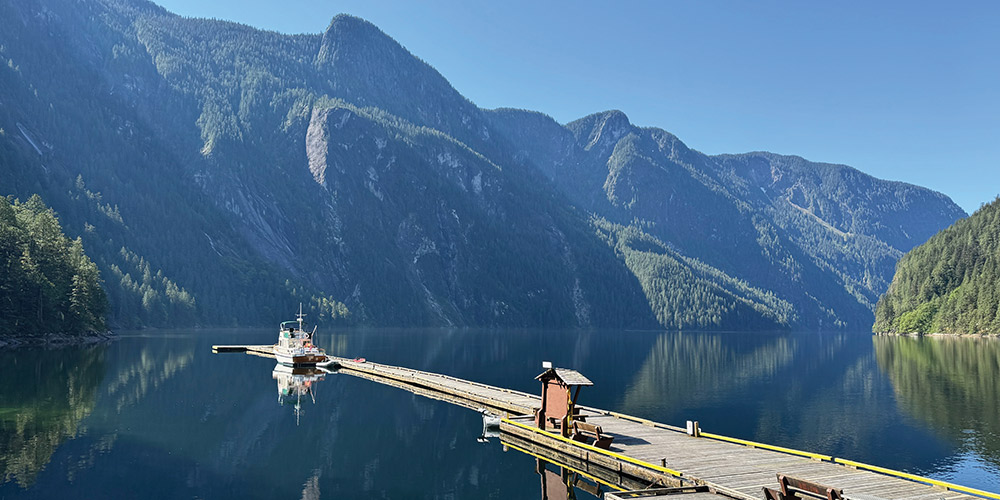
What’s your favorite story involving your boat?
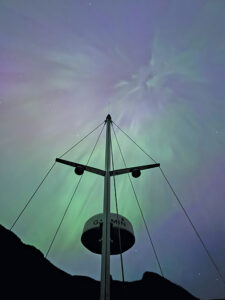
In 2024 we completed a 50 year mission by returning to Princess Louisa Inlet. I’d last been there as a 12-year-old on Mom and Dad’s boat.
We happened to hit an amazing sunny weather window in early May, and had the inlet almost to ourselves. For one whole day, until the evening slack tide at Malibu Rapids, we were the only boat at the Chatterbox Falls dock. That was also the day after the aurora borealis had put on a spectacular show, which had us spellbound for a couple hours. It was an incredible run of luck in an astonishingly beautiful place.
Describe the most challenging situation you’ve experienced on your boat and how it performed.
With bluewater sailors and experienced Alaska cruisers reading this, I don’t have any extreme weather tales to share. We’ve been caught out in the Strait of Juan de Fuca a few times when the weather forecast and reality didn’t match—meaning a few hours spent with lots more vertical motion than expected. Grand Banks don’t have a lot of flare in the bow, so when seas get steep there’s loads of spray. We’ve buried it deep but I’ve yet to see green water over the bow, and I’m ok with that. The original bell is on the mast, and if the boat pitches particularly hard when diving into a trough the bell will ring. That’s one way to keep track of whether the seas are getting worse or better.
As folks often say, the boat can take a lot more punishment than the people aboard. As an Inside Passage cruiser, I’m happy to not push those boundaries.
Where do you plan to take your boat? Do you have a dream destination or adventure?

We’ve been working our way farther north each season, but so far life choices have meant trips of three weeks or less—and in a slow boat that means we haven’t been very far. In May we completed another 50 year mission of mine, finishing my Dad’s journey to Prideaux Haven. As trip durations grow, the Broughtons are certainly on the list, and Haida Gwaii is my current dream destination.
If you could have any other boat, what would it be and why?
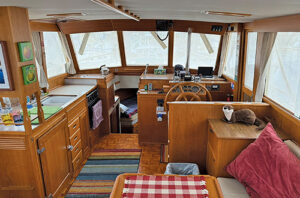
Fundamentally, there’s nothing I’d change; Gravenstein is the right boat for me and the friends who travel aboard. Larger Grand Banks are gorgeous, but the ownership and operating costs go up fast with length, and we like poking into little coves where more size and depth quickly become disadvantages. It pleases me how many sailor friends of a certain age have said to me that when they’ve had enough of hauling halyards, a Grand Banks 42 is on their short list. That says a lot.
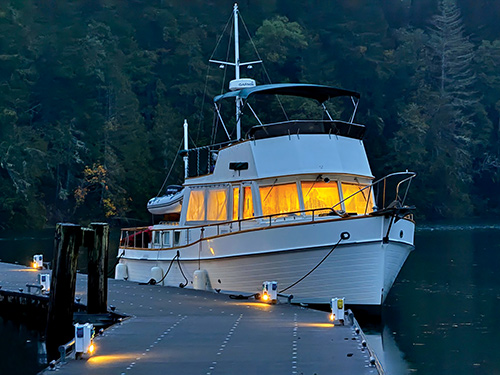
If you’d like to share the story of your boat in a MY BOAT column, we’d love to hear from you. Please email 48° North Editor Andy Cross to get started (andy@48north.com).
